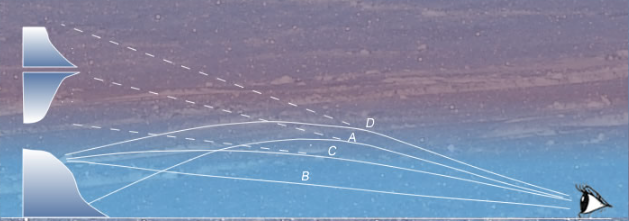Ground Mirage - OPOD
Ground Mirage: Exploring the Fascinating World of Optical Illusions
Optical illusions have captivated human imagination for centuries, with their ability to deceive our senses and challenge our perception of reality. One intriguing phenomenon within the realm of atmospheric optics is the ground mirage. In this article, we will delve into the mesmerizing world of ground mirages, shedding light on their formation and characteristics.
The Scottish Highlands Mirage: A Miniature Superior Mirage
An enchanting scene captured by Dave Pike in the Scottish Highlands unveils a narrow band of a distant hillside that appears to be strongly miraged as rays from it graze the nearby snowy slope. This captivating display is known as a ground mirage, which can resemble a miniature superior mirage or even a Fata Morgana.
The formation of this mirage can be attributed to the refraction of light across temperature gradients between the cold air near the snow surface and the warmer air above. As the snow surface radiatively cools overnight, it cools the air in its proximity. This temperature difference creates varying air densities, leading to the bending of light rays and the creation of a mirage.
Unraveling the Complexities of a Classical Superior Mirage
To gain a deeper understanding of ground mirages, let's explore the formation of a classical superior mirage. When a ray of light (labeled as 'A') originates from a lower point on a distant hillside, it can undergo strong refraction as it crosses temperature gradients between cold and warmer air. This refraction causes the ray to appear as if it is coming from above the actual object, creating an illusion for the observer.
In addition to ray 'A', other rays leaving higher points on the hillside can reach the observer's eye either directly ('B') or through refraction at the boundary between cold and warm air ('C'). These various paths of light result in an inverted image of the hillside. Furthermore, additional refraction ('D') contributes to the creation of an erect image above the inverted one, further enhancing the complexity of the mirage.
The Enigmatic Scottish Hillside Mirage
The mirage observed in the Scottish Highlands, captured by Dave Pike, presents a unique challenge in terms of unraveling its intricacies. Parts of this mirage appear inverted, while others appear erect. This blending of characteristics makes it resemble the enigmatic Fata Morgana, a complex and elusive mirage known for its intricate patterns and multiple layers.
Studying mirages like the one found in the Scottish Highlands offers valuable insights into the complexities of atmospheric optics. By examining the interplay between temperature gradients and light refraction, researchers can gain a deeper understanding of the mechanisms that give rise to these captivating optical illusions.
Conclusion: A Window into the Wonders of Atmospheric Optics
Ground mirages, such as the Scottish Highlands Mirage, provide us with a glimpse into the extraordinary world of atmospheric optics. By exploring the formation and characteristics of these optical illusions, we gain a deeper appreciation for the intricate interplay between temperature gradients and light refraction.
As we continue to unravel the mysteries of atmospheric optics, we unlock new perspectives on our perception of reality and the wonders that surround us. The captivating nature of ground mirages serves as a reminder of the complexity and beauty that can be found within the natural world, inviting us to delve deeper into its secrets. So, the next time you encounter an optical illusion like a ground mirage, take a moment to appreciate the fascinating interplay between light and atmosphere that brings these enchanting phenomena to life.

Mini Mirage
Dave Pike imaged this scene in the Scottish Highlands.
A narrow band of the distant hillside appears strongly miraged where rays from it graze the nearby snowy slope.
The snow surface has radiatively cooled overnight and has in turn cooled air close to it. The mirage is produced by refraction across the temperature gradients between the cold air and warmer air above.
We have in effect a mini superior mirage or even a Fata Morgana.
Image ©Dave Pike, shown with permission

Formation of a classical superior mirage.
A ray ‘A’ from low down on the distant hillside can be strongly refracted across temperature (air density) gradients between the cold and warmer air. It appears to the eye to come from above the real object. Rays leaving farther up the hillside can reach the eye directly ‘B’ or by refraction at the cold-warm air boundary ‘C’. the result is an inverted image of the hillside. Extra refraction ‘D’ gives an erect image above the inverted one.
The Scottish hillside mirage is hard to disentangle. Parts are inverted and others erect. Mirages like this approach the appearance of a Fata Morgana.
Note: this article has been automatically converted from the old site and may not appear as intended. You can find the original article here.
Reference Atmospheric Optics
If you use any of the definitions, information, or data presented on Atmospheric Optics, please copy the link or reference below to properly credit us as the reference source. Thank you!
-
<a href="https://atoptics.co.uk/blog/ground-mirage-opod/">Ground Mirage - OPOD</a>
-
"Ground Mirage - OPOD". Atmospheric Optics. Accessed on November 26, 2024. https://atoptics.co.uk/blog/ground-mirage-opod/.
-
"Ground Mirage - OPOD". Atmospheric Optics, https://atoptics.co.uk/blog/ground-mirage-opod/. Accessed 26 November, 2024
-
Ground Mirage - OPOD. Atmospheric Optics. Retrieved from https://atoptics.co.uk/blog/ground-mirage-opod/.